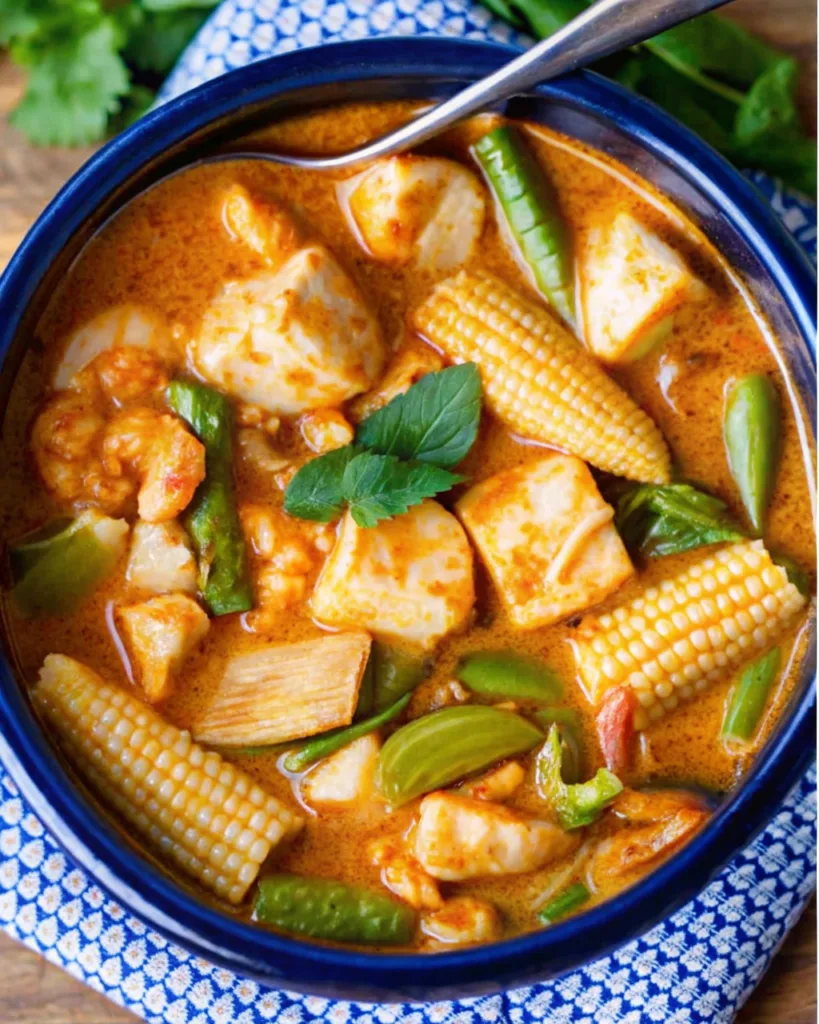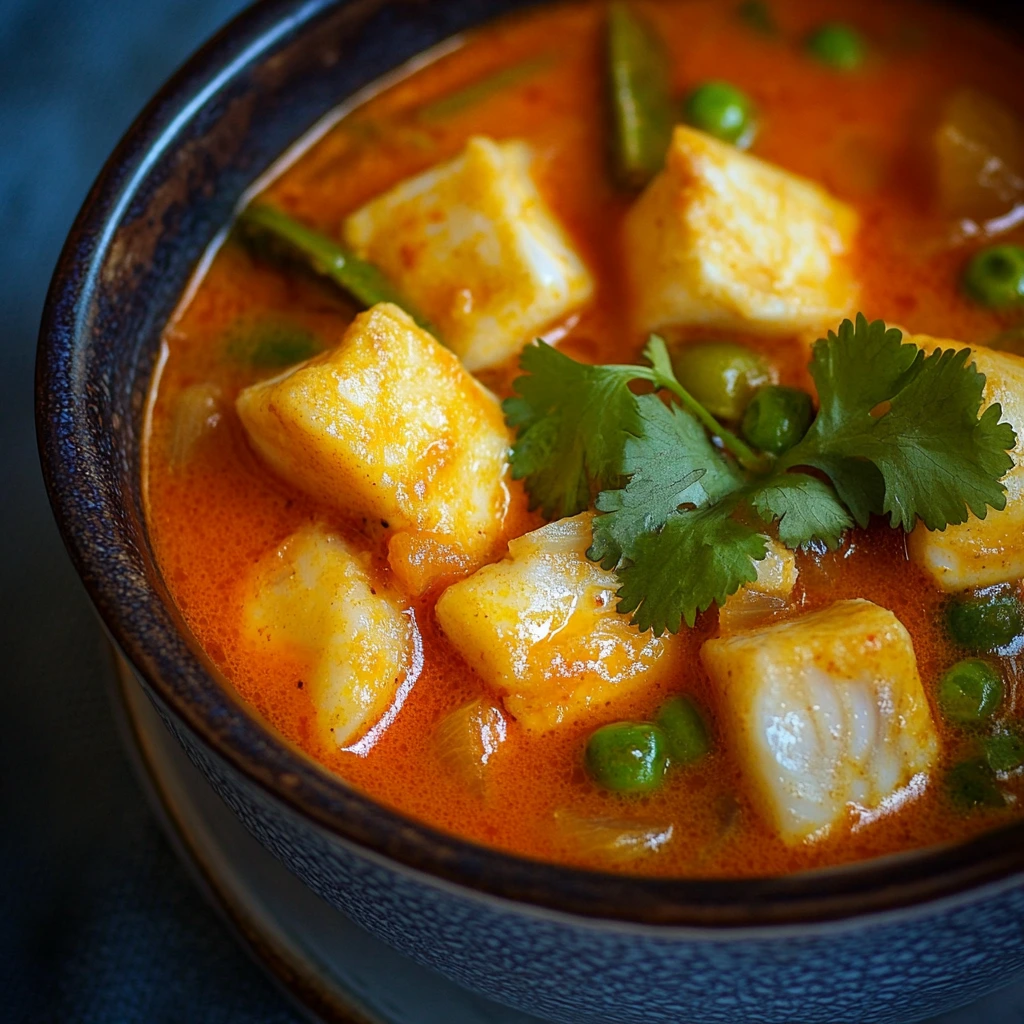Red Thai fish curry is one of those dishes that combines bold flavors, fresh ingredients, and a comforting warmth in every bite. Loved across the globe for its rich coconut base and layers of aromatic spices, this dish makes a perfect weeknight dinner or a special weekend treat. With the perfect balance of spicy, sweet, and savory flavors, it’s a healthy, delicious way to enjoy fish without much effort.
In this guide, you’ll learn everything you need to know about making Red Thai fish curry at home—from the essential ingredients and step-by-step instructions to pro tips, serving ideas, and storage guidelines. We’ll also explore variations to suit every palate. Whether you’re an experienced home cook or just starting out, this recipe will become a regular on your dinner table.
What is Red Thai Fish Curry?
Origins of Red Thai Fish Curry
Red Thai fish curry originates from Thailand’s vibrant food culture, known for its balance of flavors—spicy chili, tangy lime, sweet coconut milk, and savory fish sauce. At the core of this dish is red curry paste, a fragrant blend of dried red chilies, garlic, lemongrass, galangal, and an array of aromatic spices. This infuses the curry with its distinctive vibrant color and rich, layered flavor profile.
Thai cuisine is all about harmony, and Red Thai fish curry is a perfect example. The mildness of firm white fish works beautifully with the richness of the curry sauce. It’s a dish that’s deeply rooted in tradition yet incredibly versatile, allowing for easy adaptation with local ingredients.
Why it’s a Healthy and Flavorful Choice
Aside from being delicious, Red Thai fish curry is a nutrient-rich meal. Fish delivers a rich source of lean protein, omega-3 fatty acids, and vital vitamins, while coconut milk contributes nourishing fats that create a smooth, velvety texture. The addition of fresh vegetables like capsicum and green beans boosts the fiber and micronutrient content.
Slow simmering allows this curry to retain the ingredients’ authentic flavors and wholesome nutrients. Plus, the spices used in red curry paste—like turmeric and ginger—are known for their anti-inflammatory properties, making this dish as healthy as it is comforting.
Key Ingredients for Authentic Red Thai Fish Curry
Essential Spices and Aromatics
The secret to a perfect Red Thai fish curry lies in using the right blend of spices and aromatics. The hero ingredient is the red curry paste, traditionally made from dried red chilies, garlic, galangal, lemongrass, kaffir lime zest, and coriander seeds. For convenience, you can buy a high-quality store-bought version, but homemade paste brings unparalleled freshness.
Coconut milk forms the creamy base of the dish. Light coconut milk is a healthier choice but still maintains the richness. Kaffir lime leaves add a citrusy aroma that elevates the flavor, while a small amount of fish sauce brings a savory, umami depth.
Capsicum (both red and green) adds sweetness and crunch, balancing the spice. Green beans are another classic addition, offering fiber and a pop of color to the curry.
Best Types of Fish for Curry
Choosing the right fish is essential for Red Thai fish curry. You’ll want firm white fish that can hold its shape during simmering. Popular choices include:
- Cod
- Snapper
- Halibut
- Sea bass
Cut the fish into bite-sized chunks so they cook evenly. Avoid very delicate fish that may break apart in the sauce. Frozen fish can also be used if fresh isn’t available, but make sure it’s fully thawed and patted dry before cooking.
By selecting high-quality fish and fresh aromatics, you’ll achieve an authentic flavor and texture every time.
Step-by-Step Instructions to Make Red Thai Fish Curry
Building the Flavorful Curry Base
The foundation of a delicious Red Thai fish curry is a richly flavored sauce. Start by placing a large, heavy-based pan on medium heat. Add the red curry paste directly to the pan and sauté it for about a minute. This brief cooking process releases the paste’s aromatic oils and enhances its rich, layered flavors.
Once fragrant, slowly stir in the light coconut milk, holding back a few tablespoons for later. Add the thinly sliced kaffir lime leaves along with the vibrant red and green capsicum strips. Allow the mixture to come to a gentle boil before lowering the heat. Allow it to gently simmer for about 10 minutes so the spices and aromatics can thoroughly permeate the creamy base.
Adding the Fish and Vegetables
For a thicker sauce, mix the reserved coconut milk with the cornflour in a small bowl and whisk until it forms a smooth mixture. Gently pour this mixture into the simmering curry, stirring constantly until the sauce takes on a silky consistency.
Gently add the fish chunks to the pan, stirring just enough to coat them with the sauce without breaking them apart. Cover with a lid and allow to cook slowly for 4–5 minutes, until the fish is tender and flakes effortlessly with a fork.
As the fish cooks, steam the fresh green beans for a few minutes until they become vibrant and tender-crisp. Warm the microwavable brown rice according to the packet instructions so that everything is ready to serve at once.
When ready, arrange the steamed green beans and rice on plates or in bowls, then ladle the fragrant Red Thai fish curry generously over the top. For extra color and zest, garnish with coriander leaves, fresh chili slices, and a wedge of lemon. This final touch elevates both the presentation and the flavor, making every serving look as amazing as it tastes.
Nutrition and Health Benefits of Red Thai Fish Curry
Nutritional Breakdown per Serving
One of the best things about Red Thai fish curry is that it’s both flavorful and nourishing. Each serving provides a balanced combination of lean protein, complex carbohydrates, and healthy fats. Below is the approximate nutritional profile per serving:
| Nutrient | Amount |
|---|---|
| Energy | 1933kJ/462 cals |
| Protein | 37.9g |
| Total Fat | 12.4g |
| Saturated Fat | 7g |
| Carbohydrates | 52.7g |
| Sugar | 6.6g |
| Fibre | 7.6g |
| Sodium | 236mg |
| Calcium | 94mg |
| Iron | 2.2mg |
This nutritional balance makes Red Thai fish curry a great option for a satisfying dinner that doesn’t weigh you down. The lean white fish supplies high-quality protein to support muscle repair, while the brown rice and vegetables add fiber and slow-release energy.
Health Benefits of Fish and Coconut Milk
Fish is a natural source of omega-3 fatty acids, which are essential for heart and brain health. Incorporating fish into your weekly meal plan can also reduce inflammation and improve cholesterol levels.
Coconut milk, though rich and creamy, contains medium-chain triglycerides (MCTs) that your body can quickly convert into energy. When used in moderation, it adds a luscious texture without overwhelming the dish with heavy fats. The spices in the curry paste—such as ginger, garlic, and chili—also provide anti-inflammatory benefits and support immune health.
By choosing fresh ingredients and cooking at home, Red Thai fish curry becomes a wholesome meal that satisfies both your taste buds and your body.
Tips & Tricks for the Perfect Curry
How to Achieve the Ideal Balance of Flavors
The beauty of Red Thai fish curry lies in its harmony of flavors. To perfect this balance:
- Sample the curry first, then fine-tune the seasoning before adding the fish. A splash of lime juice can brighten the flavors, while a touch of fish sauce deepens the umami notes.
- If you prefer a spicier kick, stir in a few extra slices of fresh chili or a pinch of chili flakes. For a milder version, add a little extra coconut milk.
- Let the sauce simmer gently before adding the fish. This helps the flavors meld together without overcooking the seafood.
Common Mistakes to Avoid
Even simple recipes can go wrong if you’re not careful. Here are some common mistakes to steer clear of when preparing Red Thai fish curry:
- Overcooking the fish: Fish cooks quickly and will continue cooking in the hot sauce even after you turn off the heat. Stick to 4–5 minutes and check for flakiness.
- Skipping the sauté step: Cooking the curry paste briefly before adding liquid is crucial. It intensifies the aroma and gives the dish its signature depth.
- Using too much cornflour: Adding too much can make the sauce too thick and gluey. Stick to the recommended amount for a silky finish.
By following these tips, your Red Thai fish curry will taste restaurant-quality every time.

Looking for more protein-packed ideas? Try our Chicken pesto wrap for another crave-worthy lunch.
Serving Suggestions and Side Dishes
What to Serve with Red Thai Fish Curry
The vibrant flavors of Red Thai fish curry pair beautifully with a variety of side dishes. The most traditional accompaniment is steamed jasmine rice or brown rice, which soaks up the creamy curry sauce. However, you can also opt for:
- Coconut rice for extra richness
- Rice noodles for a lighter option
- Cauliflower rice if you’re watching your carbs
Adding a side of freshly steamed or stir-fried vegetables like broccoli, snow peas, or bok choy brings color and crunch. You can also serve a fresh Thai-inspired salad with lime dressing for a refreshing contrast.
Plating and Garnishing Tips
Presentation can elevate your Red Thai fish curry from simple to stunning. Serve it in a shallow bowl, arranging the fish pieces neatly and pouring the sauce evenly over them. Garnish with fresh coriander sprigs, thin slices of red chili, and a squeeze of lemon or lime. These last details boost the flavor and infuse the dish with beautiful, vibrant color.
Variations of Red Thai Fish Curry
Vegetarian or Vegan Alternatives
If you’re cooking for someone who doesn’t eat fish, Red Thai fish curry can be easily adapted. Replace the fish with firm tofu or tempeh, and use vegetable broth instead of fish sauce for a fully plant-based version. Add extra vegetables like mushrooms, zucchini, or eggplant to bulk up the dish while keeping it healthy.
Spice Level Adjustments and Add-Ons
You can easily adjust the spice level in Red Thai fish curry to suit your preference. 1. For a gentler heat, use less red curry paste or opt for a brand that’s naturally milder. If you enjoy a fiery kick, add extra chili flakes, sliced bird’s eye chilies, or even a drizzle of chili oil just before serving.
You can also experiment with add-ons like:
- Fresh pineapple for a sweet-sour contrast
- Baby corn and bamboo shoots for texture
- Thai basil for a fragrant finish

These variations allow you to customize the dish to suit different preferences without losing the essence of traditional Red Thai fish curry.
Storage and Reheating Instructions
How to Store Leftover Curry Safely
One of the best things about Red Thai fish curry is that it tastes even better the next day. To store leftovers, let the curry cool completely before transferring it to an airtight container. Keep it refrigerated in an airtight container and consume within 2–3 days for the best flavor and freshness.
If you need to store the curry for an extended period, carefully ladle it into durable, freezer-safe containers or high-quality resealable bags. Be sure to leave a small gap at the top to allow the liquid to expand as it freezes. Properly sealed, the curry will maintain its flavor and texture in the freezer for up to two months.
Reheating Tips to Preserve Flavor
When warming up Red Thai fish curry, reheat it slowly to prevent the fish from becoming overcooked.
- Stovetop: Place the curry in a saucepan and warm it over low-medium heat, stirring occasionally until hot.
- Microwave: Reheat in short intervals, stirring after each, until evenly warmed through.
If the sauce has thickened too much, stir in a splash of coconut milk or water to restore its creamy texture.
Conclusion
Making Red Thai fish curry at home is easier than it looks and offers a healthy, flavorful meal that everyone will love. With its creamy coconut base, aromatic spices, and tender chunks of fish, it’s the perfect way to enjoy a restaurant-quality dish in your own kitchen.
Now that you know the step-by-step method, tips, and variations, it’s time to try this recipe and impress your family or guests. Don’t forget to garnish it beautifully and serve it with your favorite sides for a truly authentic Thai dining experience.
Discover more delicious recipes by following us on Facebook and Pinterest for daily inspiration.
Frequently Asked Questions (FAQ)
Can I use salmon for Red Thai fish curry?
Yes, salmon is a fantastic option for Red Thai fish curry. Its naturally rich and slightly oily texture pairs beautifully with the creamy coconut-based sauce. To use salmon:
Cut the fillet into even chunks, about 1.5-inch pieces, so they cook evenly.
Add salmon towards the end of cooking and simmer gently for only 3–4 minutes to avoid overcooking.
The natural oils from salmon will make the sauce even richer, so you may want to reduce the amount of coconut milk slightly if you prefer a lighter dish.
This twist gives the curry a deeper flavor and is perfect if you enjoy heart-healthy fish with omega-3 benefits.
Can I cook Red Thai fish curry in a slow cooker?
Absolutely! Red Thai fish curry can easily be made in a slow cooker, offering a hassle-free solution for busy days:
Begin by lightly frying the curry paste in a pan to unlock its full aroma and flavor, then transfer it to the slow cooker.
Add the coconut milk, kaffir lime leaves, capsicum, and other vegetables, then cook on low for 4–5 hours or high for 2–3 hours.
Add the fish in the final 20–30 minutes of cooking to ensure it stays whole and turns out delicately tender.
The slow cooker method allows the flavors to deepen over time and creates a hands-off way to enjoy this classic dish.
Can I make Red Thai fish curry without curry paste?
Yes, you can make a version of Red Thai fish curry without curry paste, though the flavor will be slightly different. If you don’t have curry paste on hand, use these ingredients to create a quick substitute:
2 teaspoons chili powder
1 teaspoon ground coriander
1 teaspoon ground cumin
1 tablespoon minced garlic
1 tablespoon minced ginger
1 tablespoon fish sauce
A pinch of lime zest or kaffir lime leaves
Cook this mixture in oil until it reaches a thick, paste-like consistency, then continue with the rest of the recipe as directed. While not entirely authentic, it’s a great backup option.
How can I thicken the sauce for Red Thai fish curry?
If you prefer a thicker, restaurant-style sauce for Red Thai fish curry, there are several ways to achieve it:
Add a cornflour slurry (1 tablespoon cornflour mixed with 2 tablespoons coconut milk or water) during simmering. Stir until the sauce thickens.
Simmer the curry uncovered for a few extra minutes to allow excess liquid to evaporate naturally.
Add extra vegetables like eggplant or sweet potato, which release starch and help thicken the sauce.
Avoid adding too much cornflour as it can make the curry overly dense. Aim for a smooth, creamy consistency that coats the fish and rice perfectly without being too thick or too runny.

Red Thai Fish Curry
- Total Time: 35 mins
- Yield: 4 1x
- Diet: Gluten Free
Description
Red Thai Fish Curry is a creamy, flavorful dish with tender fish, coconut milk, and aromatic spices. Ready in 35 minutes for a perfect weeknight meal.
Ingredients
3 tablespoons red curry paste
400g can light coconut milk
2–3 kaffir lime leaves,
finely sliced
1 red capsicum,
cut into thin strips
1 green capsicum,
cut into thin strips
2 tablespoons cornflour
650g firm white fish,
cut into chunks
3 cups green beans
2 x 250g pouches
microwavable brown rice
Fresh coriander sprigs,
to garnish (optional)
1 red chilli, sliced,
to garnish (optional)
Lemon wedges, to serve
Instructions
- Heat a large, deep frying pan that has a lid over medium heat.
- Add curry paste and cook for 1 minute until fragrant. Add coconut milk, reserving 3 tablespoons, to the pan with lime leaves and capsicum strips. Bring to the boil, then reduce the heat and simmer for 10 minutes.
- In a small bowl, mix cornflour with the reserved coconut milk. Gradually add the mixture to the curry sauce, stirring continuously until smooth. Add the fish, stir gently, then cover and cook for 4–5 minutes, stirring once.
- Meanwhile, steam beans for 4–5 minutes and heat rice according to pack instructions.
- Serve curry with rice and beans, garnished with coriander, and chilli if using, with lemon wedges on the side.
- Prep Time: 10 mins
- Cook Time: 25 mins
- Category: keto meals
- Cuisine: American
Nutrition
- Calories: 462Kcal
- Sugar: 6.6g
- Sodium: 236mg
- Fat: 12.4g
- Carbohydrates: 52.7g
- Fiber: 7.6g
- Protein: 37.9g

